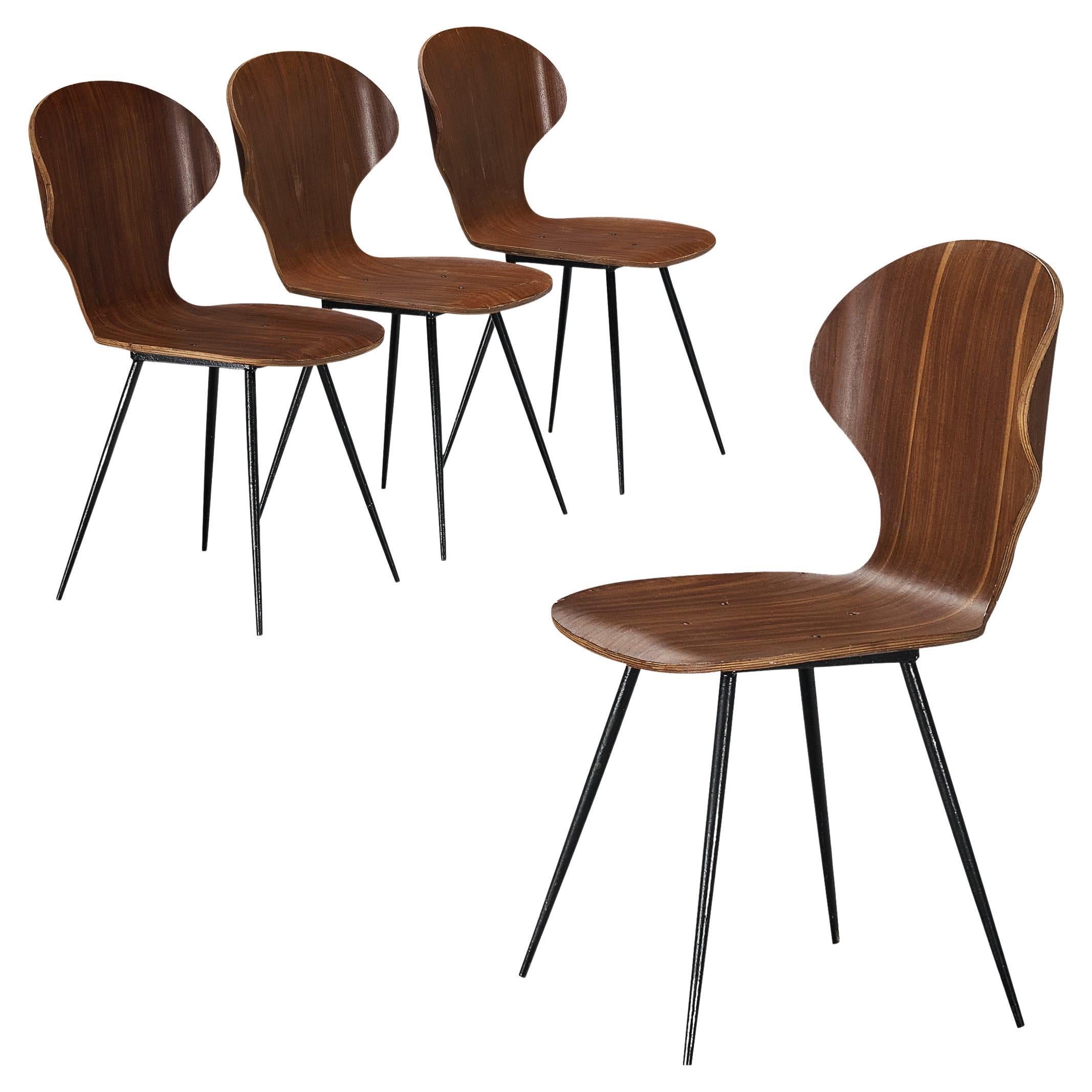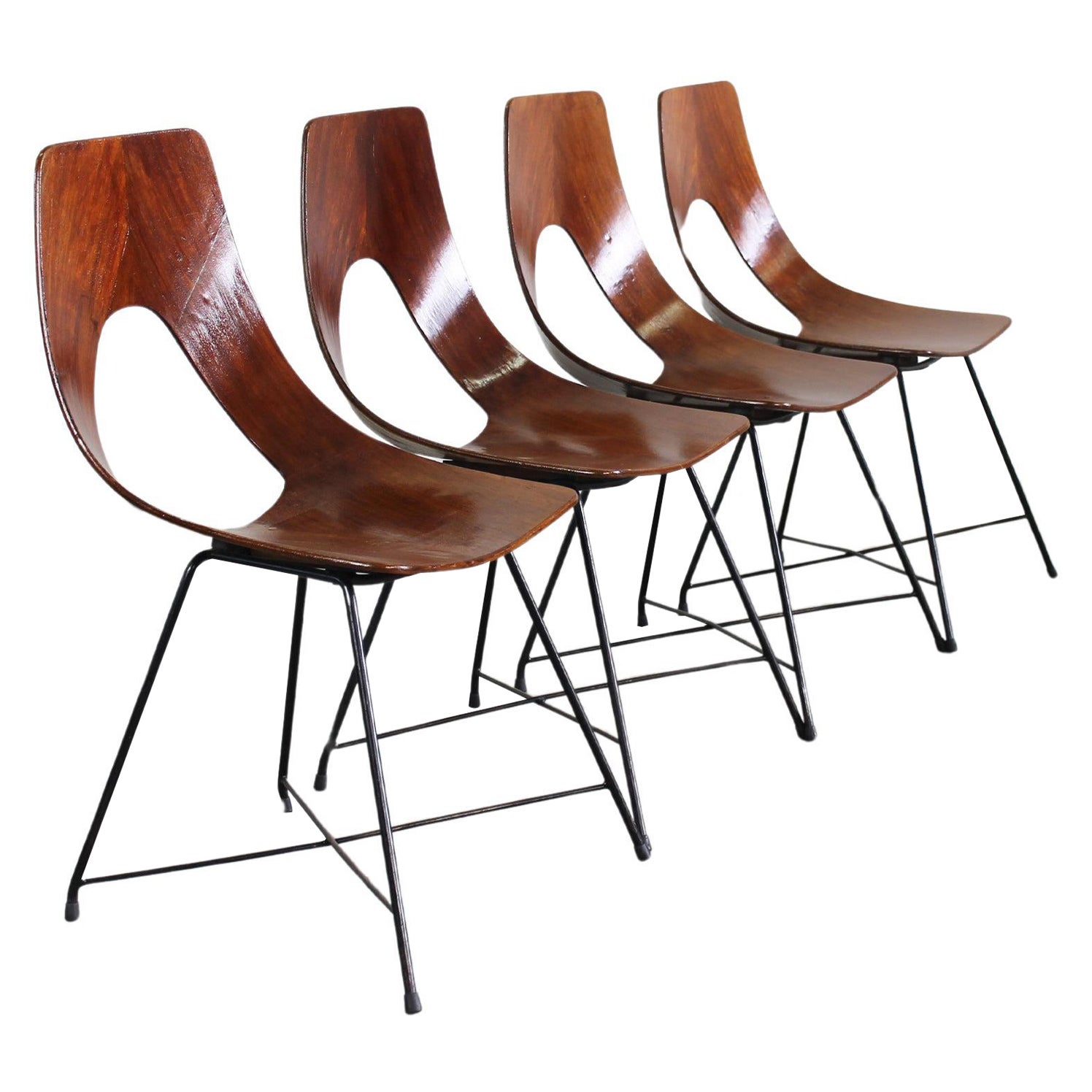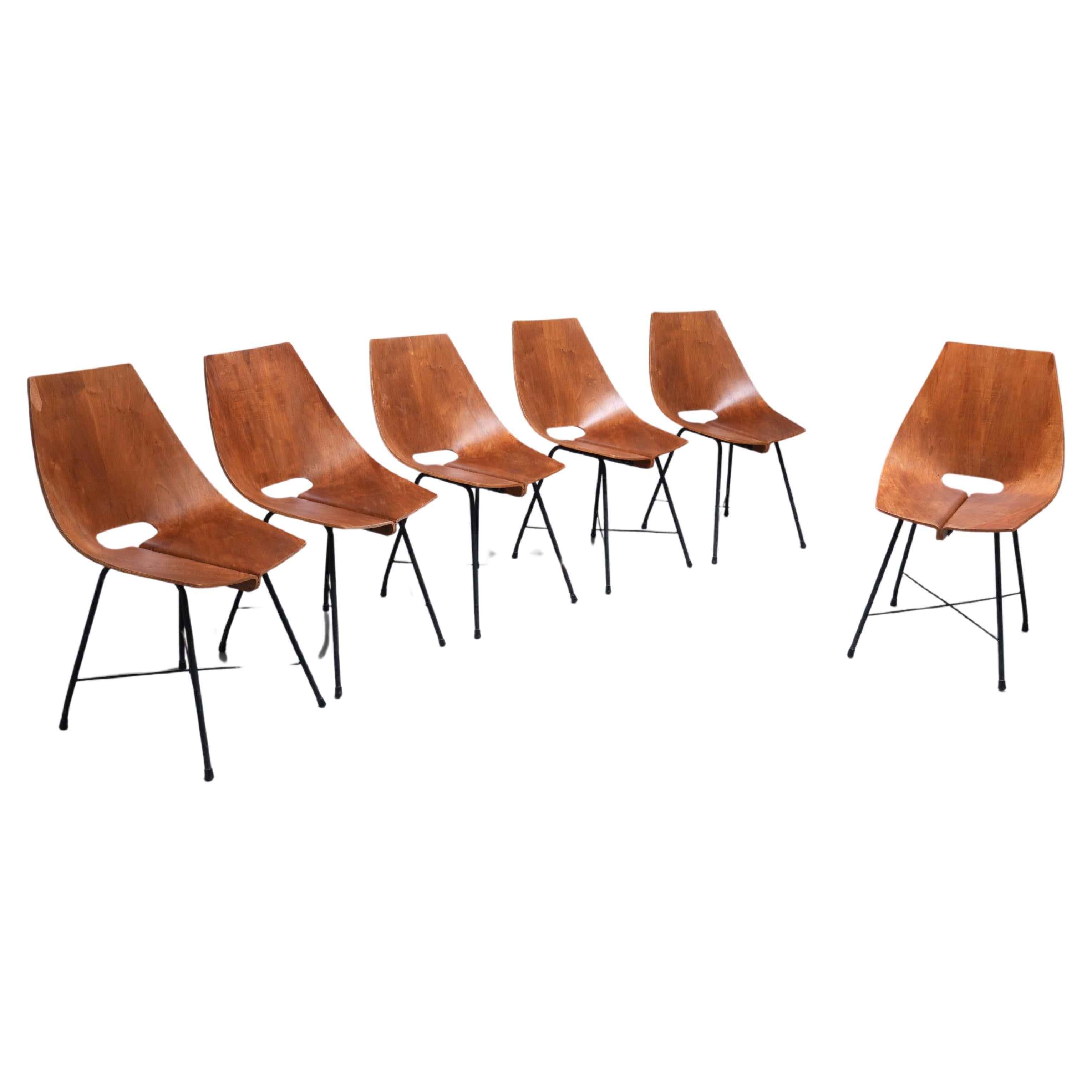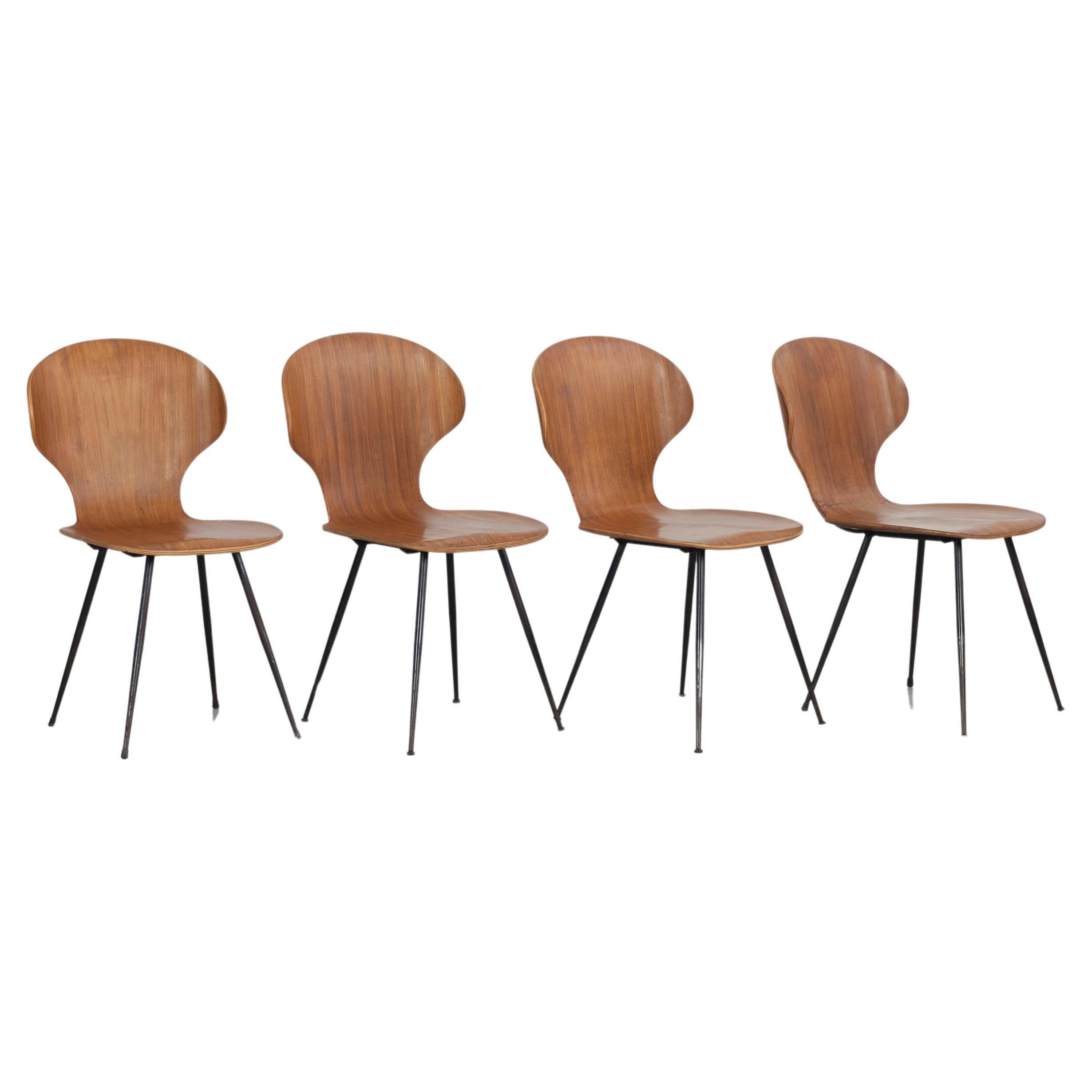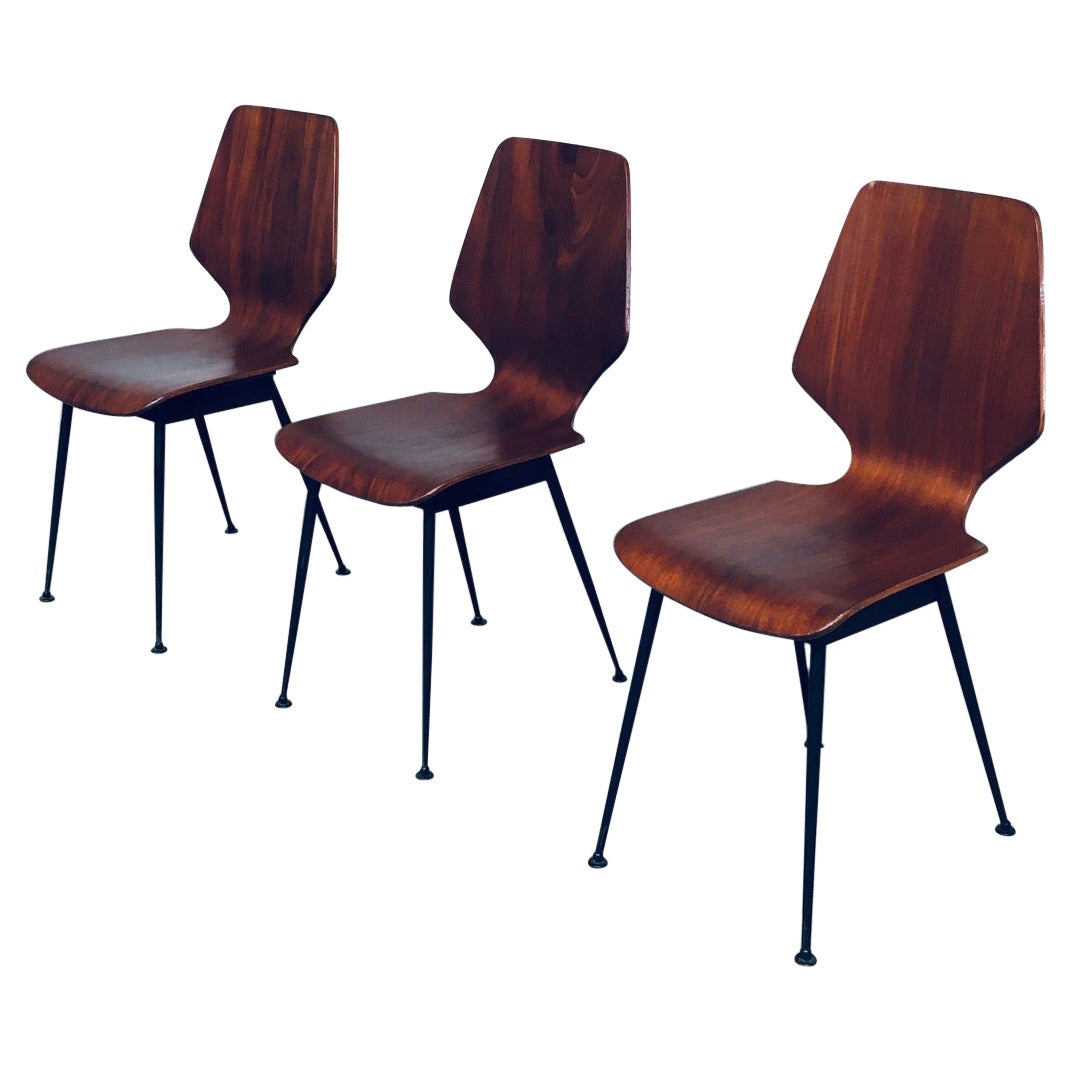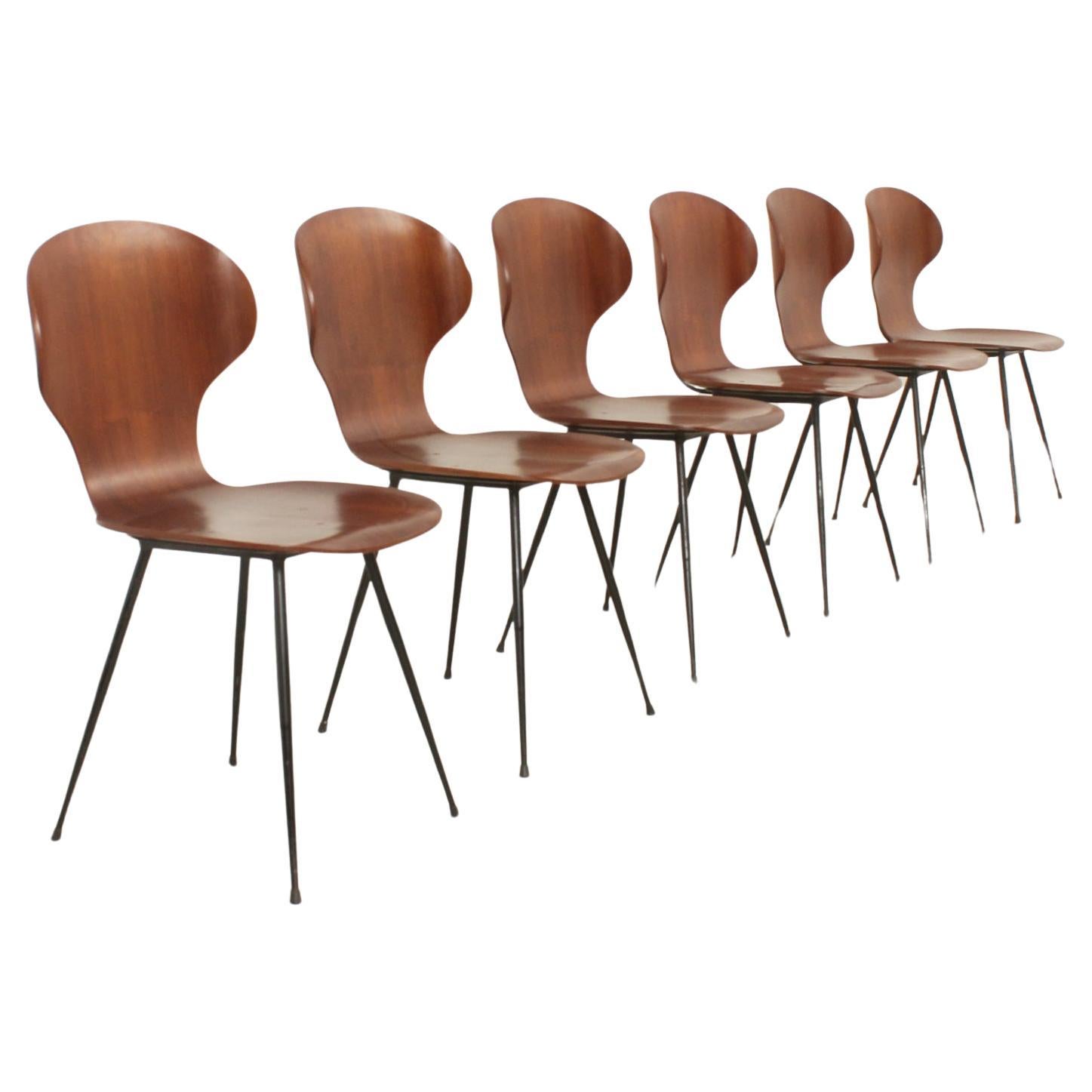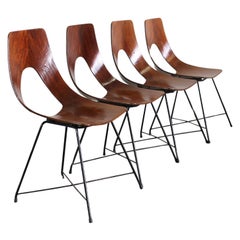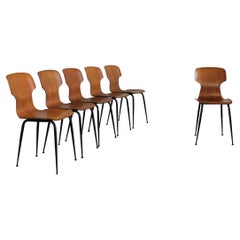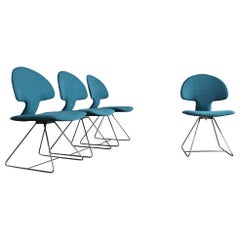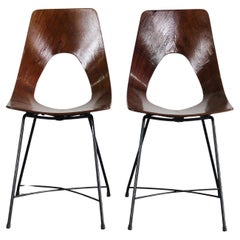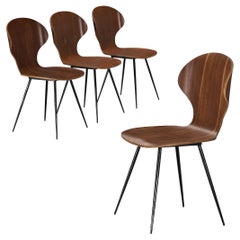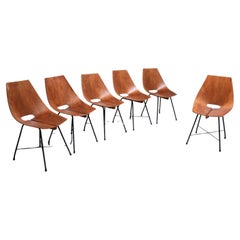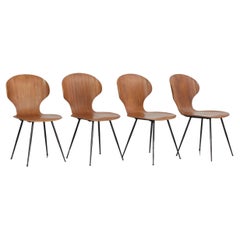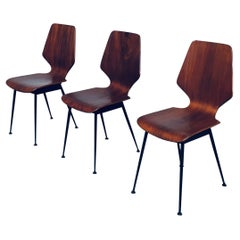Articoli simili a Carlo Ratti Set of Four Chairs in Plywood by Società Compensati Curvi 1950s
Vuoi altre immagini o video?
Richiedi altre immagini o video al venditore
1 di 9
Carlo Ratti Set of Four Chairs in Plywood by Società Compensati Curvi 1950s
4500 €per set|IVA inclusa
Informazioni sull’articolo
Set of four dining chairs with a frame in black lacquered metal and seat in curved plywood, attributed to Carlo Ratti and produced by Società Compensati Curvati in the 1950s.
In Italy, at the beginning of the XX century, industries of curved solid wood arose under license of Michael Thonet, and through the International Exhibitions the processing of curved wood became more and more widespread.
The Expo of the first decade was also attended by the wood manufacturers of Monza, while in 1905 Otto Helzer, in Switzerland, patented wooden structures in curved laminated, whose strength was equivalent to those in steel.
The Ratti brothers of Monza took their cue from the solid wood laminate to create furniture that, instead of wooden elements, used sheets of wood.
The brothers Ratti, Carlo and Mario, also began to follow the young artistic avant-gardes (cubism, futurism and abstractionism).
The mastery of wooden sculpture influenced Carlo in the design and realization of furniture of fine neo-plastic artistic workmanship and decò, receiving honors from the Prince of Piedmont Umberto di Savoia.
In 1919, in Milan, the first Lombard Exhibition of Decorative Arts was set up (later to become the Triennale) and the Ratti brothers exhibited their furniture in solid wood but also in curved panel with a new system of curvature, the one in Telo.
The canvas system was developed by the Ratti brothers with the help of a friend, Cesare Cantù.
They developed an elastomer bag in which the mould was inserted with the panel to be bent and, closing it with clamps, the air inside was removed, thus making the panel adhere to the mould.
Carlo and Mario found in the Telo system a means by which they could make objects and furniture in the three spatial directions with large surface curvatures, without limits of thickness and minimum radii of curvature.
In 1921 in Stuttgart the first Salone del Mobile was inaugurated and the Fratelli Ratti of Monza made itself known internationally by presenting solid wood furniture and also furniture in load-bearing plywood, flanked by furniture with framed and interchangeable covers.
The Expo became meeting places to verify and present the novelties in the furniture and industrialization sector and, with the development of Industrial Design, the first architects joined in the design of the furniture industries.
The Ratti Brothers, in the various international and national exhibitions, also presented incredible objects in their realization with the system in Telo.
After 1930 Carlo and Mario produced many containers for radio and folding chairs for cinema but in 1939 they divided and in Monza Mario remained who, with his sons Antonio and Angela, formed the Società Compensati Curvi.
Carlo moved to Lissone, forming with his sons Angelo and Piera and with her husband, Piero Berruti, the Industria Legni Curvati. After the war, a new bending system, the Mould and Counter-mould, was added to the existing systems from the 1950s.
After the war, the architects devoted themselves exclusively to the planning and reconstruction of the territory and the need to regain the markets put the industrialists in conditions to offer quality products, designed by architects-designers of the new generation.
Both Carlo Ratti’s and Mario’s firm began collaborating with world-famous architects such as Ignazio Gardella, Paolo Chessa, Vico Magistretti, the Castiglioni brothers, Vittoriano Vigano, Marco Zanuso, Carlo de Carli, etc.
In those years many technological objects were made with curved plywood bodies such as washing machines, televisions, radios, sewing machines, etc. while the production of furniture in a rationalistic style continued.
The new bending technologies, Mould and Counter-mould and High Frequency, allowed a remarkable mass production and, if the old system in Telo continued to exist to make extraordinary objects with Coons curves, especially the High Frequency spread all over the world.
The Japanese company Tendo Mokko invented this new bending system in 1948, trying to make plywood planes and, immediately, the company Ratti of Monza used it, while that of Lissone continued to make products with the old Mould and Counter-mould system.
This system used aluminum shapes unlike other systems that, instead, made wooden shapes, with considerable economic savings.
In 1954 a chair designed by Carlo de Carli for Cassina and made by Carlo Ratti won the "Compasso d'Oro" award as an object of considerable technical and aesthetic value.
In 1961 Carlo Ratti died and his sons Angelo and Piera, with her husband Piero Berruti, continued the activity while the third generation was entering the company.
The company transformed from Industria Legni Curvati into Carlo Ratti s.a.s and, since then, new collaborations with young architects allowed a new technological development.
Thus, the High Frequency system was introduced in the company, but the Mould and Counter-mould system was not abandoned and, above all, the Telo system that was still used for the production of samples and prototypes.
- Creatore:Società Compensati Curvati (Produttore)
- Attribuito a:Carlo Ratti (Designer)
- Dimensioni:Altezza: 80 cm (31,5 in)Larghezza: 50 cm (19,69 in)Profondità: 45 cm (17,72 in)
- Venduto come:Set di 4
- Stile:Mid-Century moderno (Del periodo)
- Materiali e tecniche:
- Luogo di origine:
- Periodo:
- Data di produzione:1950s
- Condizioni:Usura compatibile con l’età e l’utilizzo.
- Località del venditore:Montecatini Terme, IT
- Numero di riferimento:1stDibs: LU5304223682922
Informazioni sul venditore
4,9
Venditore Oro
Venditori Premium con valutazione 4,3+ e tempi di risposta entro 24 ore
Venditore 1stDibs dal 2020
129 vendite su 1stDibs
Tempo di risposta standard: 1 ora
- SpedizioneRecupero del preventivo…Spedizione da: Florence, Italia
- Politica di reso
Alcune parti di questa pagina sono state tradotte automaticamente. 1stDibs non può garantire che le traduzioni siano corrette. L’inglese è la lingua predefinita del sito.
Garanzia di autenticità
Nell’improbabile caso in cui si verifichi un problema con l’autenticità di un articolo, contattaci entro un anno per ottenere un rimborso completo. DettagliGaranzia di rimborso
Se il tuo articolo non corrisponde alla descrizione, è danneggiato durante il trasporto o non arriva, contattaci entro 7 giorni per un rimborso completo. DettagliAnnullamento entro 24 ore
Hai un periodo di tolleranza di 24 ore per annullare il tuo acquisto, senza necessità di fornire spiegazioni.Venditori professionali selezionati
I nostri venditori di livello internazionale devono aderire a rigorosi standard di servizio e qualità, garantendo l’integrità delle inserzioni.Garanzia miglior prezzo
Se scopri che un venditore ha pubblicato altrove lo stesso articolo a un prezzo più basso, applicheremo lo stesso prezzo.Consegna globale affidabile
La nostra rete di vettori leader del settore offre opzioni di spedizione specializzate in tutto il mondo, inclusa la consegna personalizzata.Altro da questo venditore
Mostra tuttoAugusto Bozzi Set di quattro sedie Ariston in compensato e metallo di Saporiti anni '50
Di Fratelli Saporiti, Augusto Bozzi
Set di quattro sedie da pranzo modello Ariston con struttura in compensato curvato e gambe in metallo laccato nero.
La sedia Ariston è stata disegnata da Augusto Bozzi e prodotta da...
Categoria
Vintage, Anni 1950, Italiano, Mid-Century moderno, Sedie
Materiali
Metallo
Carlo Ratti Set di sei sedie in compensato di Industria Legni Curvati Lissone 1950
Di Industria Legni Curvati, Carlo Ratti
Set di sei sedie da pranzo con schienale e seduta in compensato impiallacciato curvato e gambe in metallo laccato nero, disegnate da Carlo Ratti e prodotte dall'Industria Legni Curva...
Categoria
Vintage, Anni 1950, Italiano, Mid-Century moderno, Sedie
Materiali
Metallo
Vittorio Introini Set di quattro sedie da pranzo Longobarda di Saporiti 1960s Italy
Di Saporiti, Vittorio Introini
Set di quattro sedie Longobarda con gambe in metallo cromato, seduta e schienale rivestiti in tessuto blu.
La sedia Longobarda è stata disegnata da Vittorio Introini e prodotta da S...
Categoria
Vintage, Anni 1960, Italiano, Mid-Century moderno, Sedie
Materiali
Metallo
Augusto Bozzi Set di due sedie Ariston in compensato e metallo di Saporiti 1950s
Di Augusto Bozzi, Saporiti
Set di due sedie da pranzo modello Ariston con struttura in compensato curvato e gambe in metallo laccato nero.
La sedia Ariston è stata disegnata da Augusto Bozzi e prodotta da Sap...
Categoria
Vintage, Anni 1950, Italiano, Mid-Century moderno, Sedie
Materiali
Metallo
Sineo Gemignani Set di sei sedie in legno curvato Manifattura italiana anni '40
Di Sineo Gemignani
Un rarissimo set di sei sedie da pranzo interamente realizzate in legno curvato, questo set è stato disegnato dall'artista italiano Sineo Gemignani e prodotto in Italia negli anni Qu...
Categoria
Vintage, Anni 1940, Italiano, Mid-Century moderno, Sedie
Materiali
Legno
Gio Ponti (attribuito a) Set di cinque sedie in Wood e pelle di ISA Bergamo
Di I.S.A. Italy, Gio Ponti
Un set di cinque sedie da pranzo con struttura in legno, seduta e schienale in pelle imbottita, prodotto dal produttore italiano ISA Bergamo. Il design di questo set è attribuito a G...
Categoria
Vintage, Anni 1950, Italiano, Mid-Century moderno, Sedie
Materiali
Pelle, Legno
8500 € / set
Spedizione gratuita
Ti potrebbe interessare anche
Carlo Ratti Set di quattro sedie da pranzo in compensato e metallo
Di Industria Legni Curvati, Carlo Ratti
Carlo Ratti per l'Industria Legni Curvati, set di quattro sedie da pranzo in compensato con finitura in teak e metallo, Italia, anni Settanta.
Un elegante set di sedie da pranzo ita...
Categoria
Vintage, Anni 1970, Italiano, Mid-Century moderno, Sedie per sala da pranzo
Materiali
Metallo
Set di 6 sedie da sala da pranzo di Carlo Ratti in compensato e metallo, Italia, 1954
Di Carlo Ratti, Società Compensati Curvati
Abbiamo restaurato completamente questo set aggiungendo nuovi piccoli pezzi di impiallacciatura (dove necessario) a tutte le sedie e laccandole tre volte. È stato necessario sostitui...
Categoria
Vintage, Anni 1950, Italiano, Mid-Century moderno, Sedie per sala da pranzo
Materiali
Metallo
Set di 4 sedie in legno curvato di Carlo Ratti, Industria Legni Curvati, Italia 1950s.
Di Industria Legni Curvati, Carlo Ratti
Questo modello di sedia italiana è stato disegnato negli anni '50 da Carlo Ratti per Industira Legni Curvati Lissoni ed è realizzato in legno curvato e gambe in metallo laccato nero....
Categoria
Vintage, Anni 1950, Italiano, Mid-Century moderno, Sedie per sala da pranzo
Materiali
Metallo
Sedie laterali in compensato attribuite a Carlo Ratti per Legni Curvati, Italia anni '50
Di Carlo Ratti
Sedie laterali in compensato di design italiano vintage del Midcentury Modern attribuite a Carlo Ratti per Legni Curvati. Made in Italy, periodo anni '50. Set di 3 sedie. Sedie in co...
Categoria
Vintage, Anni 1950, Italiano, Mid-Century moderno, Sedie senza braccioli
Materiali
Metallo
1920 € Prezzo promozionale / set
20% in meno
Set di sei sedie in compensato di Carlo Ratti, Italia, anni '50
Di Carlo Ratti, Industria Legni Curvati
Un set di sei sedie disegnate da Carlo Ratti per l'Industria Legni Curvati Lissoni, Italia, anni Cinquanta. Seduta in compensato e base in metallo nero.
Categoria
Vintage, Anni 1960, Italiano, Mid-Century moderno, Sedie per sala da pranzo
Materiali
Metallo
Quattro sedie Medea di Vittorio Nobili, Fratelli Tagliabue, Italia, anni '50
Di Vittorio Nobili
Un bel set di quattro autentiche sedie Medea di Vittorio Nobili per Fratelli Tagliabue, Italia, anni Cinquanta. Questo set è dotato di rare scarpe in ottone che sembrano essere state...
Categoria
Metà XX secolo, Italiano, Mid-Century moderno, Sedie per sala da pranzo
Materiali
Metallo
